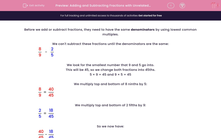Before we add or subtract fractions, they need to have the same denominators by using lowest common multiples.
We can't subtract these fractions until the denominators are the same:
| 8 | - | 2 |
| 9 | 5 |
We look for the smallest number that 9 and 5 go into.
This will be 45, so we change both fractions into 45ths.
5 × 9 = 45 and 9 × 5 = 45
We multiply top and bottom of 8 ninths by 5:
| 8 | = | 40 |
| 9 | 45 |
We multiply top and bottom of 2 fifths by 9:
| 2 | = | 18 |
| 5 | 45 |
So we now have:
| 40 | - | 18 |
| 45 | 45 |
The answer is:
| 22 |
| 45 |
Example
Work out the following, remembering to give your answer in its lowest terms.
| 2 | + | 3 |
| 3 | 4 |
Answer
The lowest common multiple of 3 and 4 is 12, because 4 × 3 = 3 × 4 = 12.
We multiply top and bottom of 2 thirds by 4:
| 2 | = | 8 |
| 3 | 12 |
We multiply top and bottom of 3 quarters by 3:
| 3 | = | 9 |
| 4 | 12 |
So we now have:
| 8 | + | 9 |
| 12 | 12 |
This gives:
| 17 |
| 12 |
But this must be changed to a mixed number.
17 ÷ 12 = 1 remainder 5.
The answer is:
| 1 | 5 |
| 12 |








